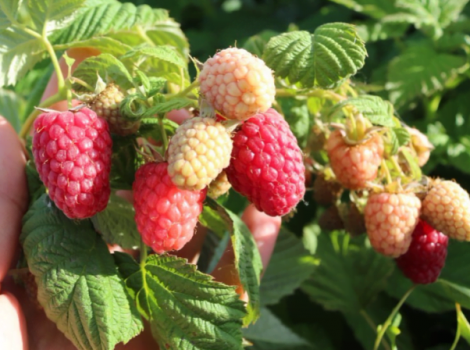Content
- 1 Grape varieties for the middle lane
- 2 Grape varieties for black soil
- 3 The best grape varieties for wine
- 4 Curly grape varieties for gazebos
- 5 Trellis grape varieties
- 6 Arched grapes on supports
- 7 Distinctive features of the formation of grapes
- 8 Caring for uncovered grapes on decorative supports
- 9 Mistakes when choosing uncovered grapes
- 10 Heading "Questions and Answers"
- 11 Features of the formation of a gazebo with a grapevine
- 12 What grape varieties can be taken for a gazebo
- 13 Features of using wild grapes on the gazebo
- 14 Only frost-resistant grape varieties do not hide
- 15 It is better to acquire the initial experience of the grower on winter-hardy varieties.
- 16 The prospect of uncovered grapes for breeding
- 17 Twelve of the best frost-resistant grape varieties
Rare plants successfully combine fruit and ornamental qualities. These include grapes. Thanks to selection, modern non-sheltering varieties not only have an exquisite taste, but also decorate the garden at any time of the year. Many of them are versatile, can grow where there is a suitable support. But, the main condition is the growing environment, which depends on the region, locality and microclimate. The selection of the variety should be started based on the ecological and biological characteristics of the hybrid. Consider in the article the best uncovered grape varieties with reviews, give their characteristics and tell you about their care.
Grape varieties for the middle lane
Working for many years on the development of new varieties, experts solve certain problems. For example, for the middle lane, one of the main aspects is winter hardiness. At the same time, it is important to preserve the taste properties of the grapes. It is advisable that caring for him was not too burdensome. These characteristics are met by varieties that were specially created for the middle lane and similar climatic conditions.

The most popular are older varieties that have been grown for over 50 years.
The most popular varieties for the middle lane are shown in the table:
| Variety name | Brief characteristic of the variety |
| Isabel | Berries are dark purple, almost black, slightly elongated, up to 1 cm in size, weighing an average of 3 g. In one bunch - 180 g. The taste is sweet and sour with a strawberry tinge. Ripens late. No problem in transportation. Winter hardiness is high. The variety is resistant to many diseases characteristic of grapes. |
| Ontario | American hybrid Winchen + Daimon. Outwardly, it looks like Isabella. The berries are round, with a bluish bloom. The weight of one bunch is 200 g. It is resistant to frost and disease. |
| Lydia (Isabella pink) | A hybrid bred in America based on the Labrusca species. The berries are rounded, acquire a pinkish transparency during ripening. The weight of one bunch is 100 g. The ripening period is 150 days. The variety is resistant to diseases, but it is affected by grape aphids, which are dangerous not only to the leaves, but also to the roots. Frost resistance is quite high, but inferior to "Isabella". |
| Ametst | One of the most frost-resistant varieties, it can withstand temperatures up to minus 350. A distinctive feature is the rapid growth of the vine and high resistance to diseases. It is considered an early variety because it ripens for an average of 100 days. The shape of the berries is elongated - conical, the color is dark pink. Berries weight 6-8 g, bunches - 270 - 300 g. Withstands low temperatures up to minus 250. They have an average resistance to diseases, therefore, it is recommended for preventive treatments with protective agents. |
⇒ Read a review of the best grape varieties from A to Z
The listed varieties are the most tested in the viticulture of the middle zone. Their long-term popularity is due to their relatively unpretentious care. In addition to them, hybrids of modern origin are widespread:
- Nadezhda Aksayskaya.
- Shunya.
- Laura.
- F-14-75.
Berries of varieties F - 14 - 75, Laura, Shunya, Nadezhda Aksayskaya.
- Victoria.
- Finding Azos.
- Super Extra.
- Victor.
- Phenomenon (Augustine, Pleven stable).
- First-Called.
- Summer Muscat.
- Gala.
- 13 Cherry.
- Aleshenkin.
- Charlie.
The variety of varieties allows you to choose the most suitable hybrids for the microclimate of each site and satisfy the taste wishes of the gardener. Read also the article: → "How to properly grow grapes from seed at home."
Berries of varieties Phenomenon, Pervozvanny, Summer Muscat, Gala.
Grape varieties for black soil
The climatic conditions of the central - climatic zone are characterized by periodic frosts with deep freezing of the soil. Such circumstances significantly shorten the growing season of grapes. Not so long ago, the cultivation of this crop was considered impossible under these conditions. In the course of the long-term work of specialists and amateur gardeners, the cultivation of certain varieties has become much more accessible. These include:
- Delight;
- Muscat delight;
- Delight is oval;
- Codryanka;
- Timur;
- Eurostandard;
- Krasa Don;
- Kishmish of Zaporozhye;
- Agustin;
- Laura;
- Tukay and others.
Hybrids with a ripening period of 125 days from the moment of opening the eyes are very popular. In the chernozem zone, this period falls approximately at the end of summer. Varieties that meet these characteristics:
- Arcadia;
- Aleshenkin;
- Agat Donskoy;
- Seedless Russball;
- Bulgaria is stable;
- Victoria;
- Delight is red;
- Delight is black;
- Pulse;
- Summer Muscat;
- Marianna and others.

A hybrid of grapes, variety Victoria
The best grape varieties for wine
Some viticulture skeptics continue to argue that the "northern" varieties are not suitable for making wine. Gardeners - lovers of the middle lane successfully refute this dogma, although there are not so many hybrids suitable for winemaking under these conditions. These include varieties with white berries:
- Muscat Golden Rossoshansky.
- Crystal.
- Prim (Poalatina).
- Early dawn.
Dark berry hybrids are presented:
- Rondo;
- Bars;
- Magic;
- Marinovsky;
- Dobrynya;
- August PE;
- 1 – 95.
To obtain quality wine, it is necessary not only to choose the desired variety, but also to wait for its full maturity. The taste of the wine and its strength depend on this. This is the content of sugar and acid as a preservative. The higher these indicators, the more valuable the wine. In the characteristics of the variety for winemaking, these properties are indicated in the ratio of parts. For example, 2: 1 is two parts of sugar, one is acid. The higher the first number, the sweeter the grapes, respectively, the higher the second, the sour.
The official ratio for white wines is 19: 8, for reds - 21: 9. The required indicators are measured with special devices, sugar content - with a refractometer, acid, using a set for titrated acidity. The indicator of acid-base balance is also important, for white wines - pH = 3.2, for red wines - pH = 3.5. For measurement, use indicator strips to determine the pH level.
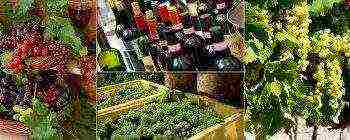
Once the grapes reach the desired characteristics, they can be harvested for making wine.
Curly grape varieties for gazebos
The grape is a woody climbing liana. She not only bears useful fruits, but also decorates the garden. Experts and amateurs alike successfully use it in landscape design for beauty and shade. This creeping shrub is especially helpful in those areas where there is no place for planting trees and large shrubs.
Like any liana, grapes require support. One of them can be a gazebo. Such a garden structure is referred to as a small architectural form (LFA). Although its main purpose is functional, the gazebo serves for relaxation, nevertheless, it bears a decorative load, decorates the landscape. In this, grapes help her. In summer, it creates beauty with leaves and fruits, in winter with intricate weaving of vines. This vine has another important quality, it creates a shadow.To make the most of this property, it is important to choose the right planting site.
For protection from the scorching sun in the afternoon, it is better to place the grapes on the southwest side of the gazebo, then the length of the shadow from noon to sunset increases in size and changes direction from north to northeast. Thus, it saves those who are in the gazebo from the heat, even if it is an open canopy on supports.
For gazebos, varieties with the greatest length of the vine are used. Winter hardiness and uniformity of crown overgrowing are also important. Non-covering varieties of American hybridization meet these qualities:
- Alpha;
- Lydia;
- Buffalo;
- Valiant.
If in the region low temperatures in winter reach minus 400, then the following are suitable:
- Lydia;
- Isabel;
- Alpha;
- Concorde.
Gardeners of the middle lane successfully use vigorous varieties derived from the Amur species of grapes:
- Amur bisexual.
- Taiga.
- Bruskam.
- Khasansky sweet.
Also popular are hybrids from the collection of A.I. Potapenko:
- August PE;
- Olenevsky black;
- Marinovsky;
- Amethyst.

To form the crown of grapes, methods are used that differ from row planting. Arbor varieties are pruned as vertical or fan cordons.
Methods for forming grapes on gazebos are presented in the table:
| Name | Features of the method |
| Vertical cordon |
As a result, the main crown is located at the top, like a roof, and the lower part is a trunk. |
| Fan crown | Forms 4 or more sleeves up to 1.5 m with fruit links after 50 cm. The stem (stem) is often absent. The sleeves are renewed only when freezing. |
Trellis grape varieties
Grapes on trellises are formed with high cordons for two reasons, shoots that are in close proximity to the ground are more easily affected by diseases than the upper ones. In addition, cold air accumulates at the foot, while warm air masses rise upward. This feature was noticed by the Austrian winegrower Lenz Moser. Its formation system, named after the author by the Moser cordon, differs from the traditional one.
Liana is evenly distributed along the support from both sides, in the form of a bush. Natural craving for the sun promotes the distribution of flower buds along the outer surface of the crown. In this case, the height of the support can reach 2 m or more. Such a construction fulfills not only a utilitarian role, but also creates a landscape effect - it decorates the garden and gives shade. Read also the article: → "DIY grape trellis".
Arched grapes on supports
Another small architectural form is the arch, which consists of two pillars connected by a rounded vault. They are usually located above the paths or at the entrance. They serve to pass under them. Their height at the top point is 2, 2 m, and the distance between the supports is equal to the length of the track, plus 30 cm on each side to strengthen the supports. The grapes are usually placed on the outside of the bases.
Often the arch is located in an open area, not sheltered from the wind. For this reason, it is important to select varieties that are resistant to drafts and frost, since they hibernate without shelter. These include "isable" hybrids of American varieties, but in addition to them, Victoria, Agat, Krasa Severa, Kishmish are successfully grown.
Tip # 1. To obtain a harvest on decorative supports, it is better to use early ripening varieties: Early Pineapple, Golden Muscat, Armalaga, Balabanovsky. Buffalo, Wilder and others.
Distinctive features of the formation of grapes
Many varieties are successfully used for all types of small architectural forms, but differ in the way they are formed.The grapes on gazebos and arches are directed to the one-sided arrangement of the fruits from the outside of the MAF, so that the shoots and fruits do not interfere with those who pass or rest under them.
Trellis allows you to create the shape of a vine in the form of a small tree or bush with a high crown. In this case, the sleeves are placed evenly around the support, the bunches hang freely and can be approached from all sides. This technique is used in landscape design, as a solitaire - a single copy.
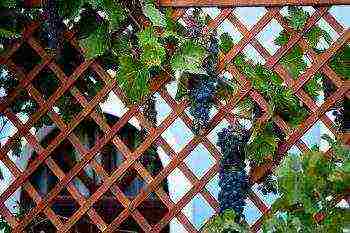
For trellises that are viewed from all sides, varieties are used, such as for gazebos.
Caring for uncovered grapes on decorative supports
The work of forming the crown and preparing for winter is greatly facilitated by non-covering varieties. They don't need to be cut in a special way like technical ones. As a rule, they are resistant to disease, so they only need preventive treatment against pathogens. A popular way to increase yields and protect against diseases is to treat the crown with natural remedies:
- solution of milk or milk whey 1:10;
- 10% mullein infusion.
Non-covering varieties do not need to be removed from the support for the winter, because they, like ordinary shrubs, tolerate cold in the open. In order for the grapes to successfully endure frosts, it is important to water and feed them well. For each bush, 4 buckets of warm +200 water are needed, in which ½ kg of ash is mixed. Read also the article: → "Rules for caring for grapes in the open field: watering, pruning, bait".
Tip # 2. In spring, watering is carried out before flowering, and the next after flowering. With the onset of ripening of berries, watering is canceled.
Mistakes when choosing uncovered grapes
Mistake # 1. Planting varieties not typical for the area.
Modern Internet services for the distribution of planting material confuse gardeners by offering grape varieties that are completely unsuitable for the conditions of the middle lane. As a rule, these are thermophilic varieties that do not hibernate at low temperatures.
Mistake # 2. Dense planting near decorative supports.
If the goal is to create shadow, then this arrangement is warranted. But if harvesting is expected, then the distance between the bushes must be maintained, as in the technological planting of the variety, otherwise the berries will be small and sour from lack of sun.
Mistake number 3. Planting grapes without taking into account the location of the MAF on the cardinal points.
The most illuminated place is the southern or southeastern sides of the support or arbor. In this position, the grapes will receive the longest duration of illumination.
Heading "Questions and Answers"
Question number 1. We planted an uncovered medium-ripening grape variety, but the berries did not ripen. Why?
The ripening period is determined from budding to full maturity of the fruit. These times are often indicated for warm climatic regions. Most likely, the required period is shorter in your area. It is better to choose early maturing varieties.
Question number 2. The grapes wintered well, and in the spring the lower branches dried out. Why?
For some varieties, spring temperature drops are more dangerous than frosts. Lower shoots are more susceptible to freezing because cold air masses accumulate closer to the ground.
Question number 3. For several years the grapes were healthy, this year they are heavily covered with a white bloom. What happened to him?
This is downy mildew - mildew, the most common and harmful disease. Spread by wind, insects and birds. It was not worth waiting for infection, even disease-resistant varieties are treated with fungicides for prophylaxis. This can be done before the ovary appears on the bunches.
Question number 4. How many grape bushes should be planted near the arch?
It depends on the width of the support. At least 3 m wide for each plant.
Question number 5. How high can grapes be grown on a gazebo?
The optimum height is 3 - 3.5 m, this is the size of the grapes that are convenient for pruning.
Rate the quality of the article. We want to be better for you:

Growing grapes in a gazebo
The arbor, entwined with grapes, always attracts attention. How beautiful a twisting vine looks with dense foliage, on which, like precious stones, amber, ruby or dark amethyst bunches of grapes shine! It becomes much more pleasant to rest in the gazebo from the proximity of such beauty. The article will tell you which grapes to plant on the gazebo?
Features of the formation of a gazebo with a vine
Grapes are a highly palatable crop with incredible vigorous growth potential. By its nature, it is a liana that lets out meter-long loops that, in one season, braid everything that is nearby.
The natural task of the plant is:
- Craving for the sun.
- Accumulation of nutrients.
- Growing fruit for reproduction.
Each bush planted can reach a height of over five meters up, while its clusters are located as high as possible.
Tip: Qualitative formation of grape bushes, correct pruning and garter will allow you to achieve the desired results. A healthy vine has tremendous regenerative power, it can be mercilessly cut and placed on the gazebo in any way.
After giving the desired shape to the structure, you can achieve:
- Rational use of the site.
- Provide sufficient natural light and good airflow for the plant.
- Increase disease resistance.
- Increase productivity indicators.
When talking about the formation of grapes, the terms are usually used:
- Stam - this is the trunk of the grape from its base to the beginning of branching. It happens:
- root;
- barrel.
- Sleeves are perennial branches, in which the length depends on the type of formation. A sleeve up to 10 centimeters long is called a horn.
- Fruit link - part of the grape bush after pruning. It combines the replacement knot with the fruiting vine.
- Annual vine Is a vine that grows from a bud this year. She:
- young;
- green;
- soft.
- Stepson - a developing shoot in the leaf axil of the main shoot from the "summer" grape bud.
- Replacement knot or annual shoot, which was cut in two buds in the fall, left to increase the fruiting vine for the next year.
- Fruiting vine left during the formation of the vine for the ripening of fruits on it in the current year.
- Trellis is an artificial support for the entire grape bush.
The grapes are able to form from each bud, which has been preserved after winter, ready-made shoots for fruiting. If you do not interfere with the natural growth of the plant, the number of vines will increase many times every year, this will have a very negative impact on the quality of the future harvest.
The number of shoots and their type may depend on:
- Varieties. The grapes for the gazebo are selected with strong, powerful growth, resistant to diseases and severe frost up to (-28 ° C).
- Bush shapes.
- Development of the fruit link.
In any case, when forming a gazebo with your own hands, it is necessary to ensure abundant fruiting of the vine.
What grape varieties can be taken for a gazebo
Tip: If the land plot is limited, grapes should be planted for the gazebo, while the varieties must be taken with different ripening periods, which will allow you to have fresh produce throughout the season.
The instruction indicates that in the gazebo between the rows of grapes the distance should be over 2.5 meters, it depends on the wishes of the owner. About two meters remain between the bushes. Before planting grapes on the gazebo, you must choose the right place on the site. Grapes should not be planted on the north side, this can inhibit its growth and lead to the death of seedlings.
When planting grapes for a gazebo, it is better to use the following varieties:
- FV-3-15 or Elegant, very early.
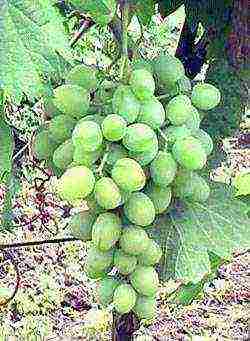
Grape variety Elegant
Its features:
- medium-sized, fairly productive variety;
- the berries are green and white;
- with nutmeg flavor;
- fruits weighing up to 8 grams;
- the weight of the bunches reaches 600 grams;
- sugar content up to 26%;
- full ripening occurs in the third decade of July;
- has a high resistance to many diseases;
- plant frost resistance up to (-26 ° C).
- Muscat Pleven, which is shown in the photo.
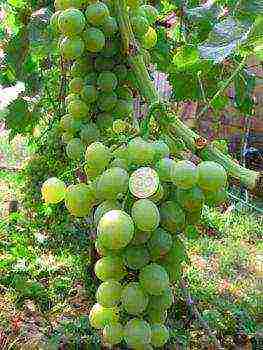
Variety Muscat Pleven
This is a variety bred by Bulgarian breeding:
- has great strength of growth;
- white berries;
- weighing up to 8 grams;
- bunch weight up to 600 grams;
- with nutmeg fruit aroma;
- can persist on the bushes for a long time;
- accumulates sugar up to 22%;
- disease resistance up to 2.0 points;
- he does not need chemical treatment;
- frost resistance up to (-28 ° С);
- not affected by wasps.
- Super-Extra grapes near the gazebo were bred by Russian selection:
- ripening time - end of July;
- sizes of white berries over 10 grams;
- weight of bunches up to 800 grams;
- has a high yield;
- high resistance to many diseases;
- frost resistance up to (-25 ° С).
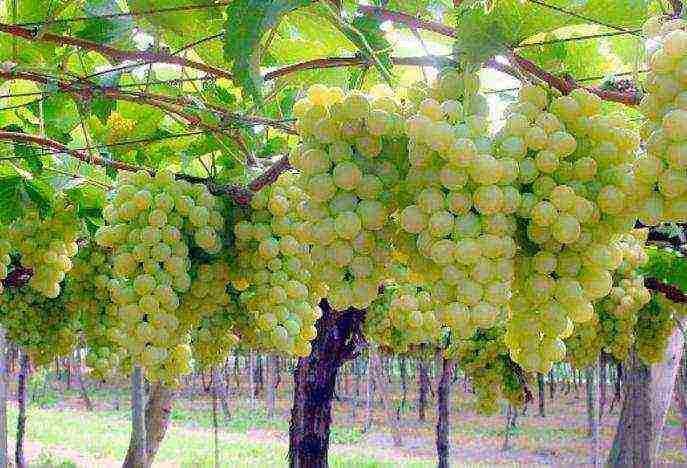
Super-Extra Grapes
- Galbena Nou was obtained as a result of Moldovan selection. Its features:
- tall;
- amber-white, large fleshy juicy berries, weighing up to 8 grams;
- with the aroma of nutmeg;
- weight of bunches up to 800 grams;
- has good commercial qualities;
- high resistance to many diseases and various pests;
- frost resistance up to (-25 ° С).
- Ruby grapes. Growing this variety on a gazebo gained popularity as a result of Russian selection.
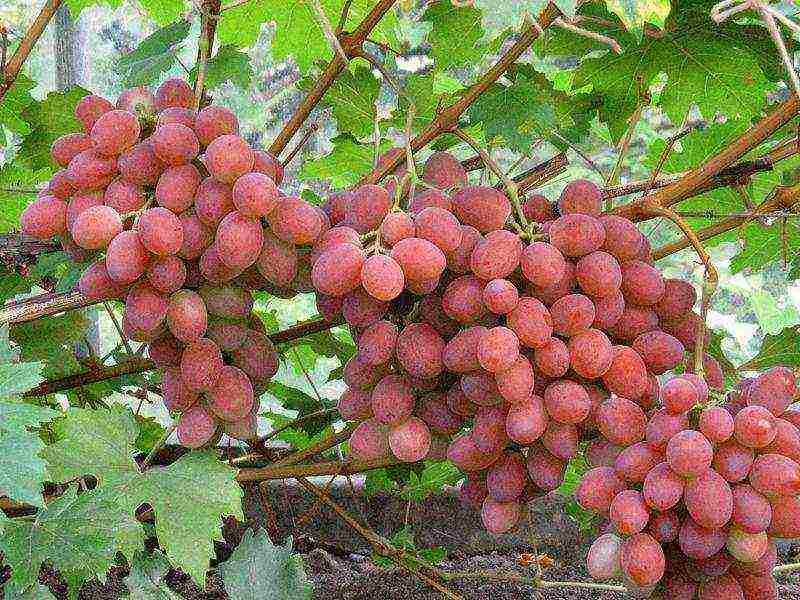
Ruby grapes on the gazebo
- Its features:
- medium-sized;
- with large light ruby berries up to 14 grams;
- with a mild nutmeg flavor;
- the mass of bunches is up to 1.3 kilograms;
- the variety is very productive;
- withstands temperatures up to (-25 ° С);
- good presentation;
- tolerates transportation well;
- increased resistance to fungal diseases, up to three points.
Early varieties can also be grown for gazebos.
Such as:
- Delight. A table zoned variety that is well adapted to various soils and weather conditions:
- vigorous;
- oval and round berries up to 8 grams, with a slight tan;
- with a pleasant taste:
- with sugar accumulation up to 26%;
- high-yielding;
- the mass of the bunch is more than one kilogram;
- on the bushes, the harvest is preserved until frost;
- is resistant to disease;
- perfectly transported;
- frost resistance up to (-26 ° С);
- great for forming arched structures.
- FV6-5, or Kesha, bred by Russian breeders:
- has great strength of growth;
- bisexual;
- white fruits up to 16 grams;
- oval;
- sweet, harmonious taste;
- sugar content up to 24%;
- the mass of large loose bunches is up to 1.5 kilograms;
- high resistance to many diseases;
- frost resistance up to (-25 ° С);
- high endurance during transportation;
- high marketability.
- Augustine, or Pleven, was bred by Bulgarian selection. Is different:
- high vigor of growth;
- yellow-white berries weighing up to 7 grams;
- weight of bunches up to 700 grams;
- can be stored on bushes for a long time;
- high resistance to the appearance of fungal diseases up to 2.5 points;
- resistance to temperature (-24 ° C).
- Orion. Is different:
- strong growth;
- pinkish-black berries of harmonious taste, weighing over 10 grams;
- large loose clusters of more than one kilogram;
- high-yielding;
- bisexual;
- with a good presentation;
- weakly affected by wasps;
- frost resistance up to (-25 ° С).
For the decoration of arches and arbors, you can also grow early-medium varieties.
These include:
- FV-6-6, or Talisman, is the variety with the largest and most reliable fruits. Its features:
- pleasant taste with a light nutmeg;
- powerful force of growth;
- harmonious white berries up to 22 grams in weight;
- bunch weight up to 1200 grams;
- accumulation of sugar up to 23%;
- good resistance to fungal attack;
- frost resistance up to (-25 ° С);
- when formed on gazebos and long pruning from 12 to 20 eyes, bunches can be obtained weighing about 2.5 kilograms;
- unisexual variety, but with good pollination.
- Gift to Zaporizhzhia. Variety with strong growth and large fruits:
- tastes good;
- green-white berries up to 20 grams;
- weight of bunches over 1500 grams;
- high-yielding;
- with high qualities for sale;
- with good resistance to many diseases;
- frost resistance up to (-25 ° С)
- they can hang on their bushes until frost;
- has a tendency to overload, which requires the formation of a bush;
- trimming should be done from 12 to 20 eyes;
- prefers powerful formations;
- unisexual variety, but well pollinated.
- Miner. Has a strong root system and strong growth. Features of the variety:
- shiny black, round, oval or pear-shaped berries up to 10 grams;
- black pulp with cherry flavor;
- bunch weight is more than 800 grams;
- very high yield;
- resistant to the appearance of fungal diseases;
- does not require chemical protection;
- frost resistance up to (-26 ° С).
From medium table varieties for gazebos are grown:
- Frumoasa alba, bred by Moldovan breeders, medium-sized. Frost resistance up to (-25 ° С).
- Anthony the Great is a variety of Russian breeders, vigorous, with large, very beautiful clusters up to 2.5 kilograms. High productivity, frost resistance up to (-25 ° С). Resistance to mildew and powdery mildew up to three points.
There are still a large number of cultivated varieties, which grapes are best for a gazebo - the video in this article will tell you.
Features of using wild grapes on the gazebo
A special place is occupied by maiden, or wild grapes on the gazebo (see. DIY grape gazebo in the country). Its lush greenery creates a refreshing coolness, and practically does not require maintenance, therefore the price of such a structure is minimal.
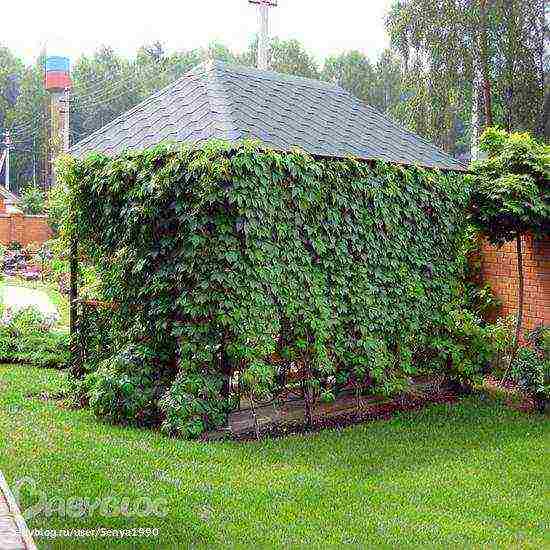
Gazebo under wild grapes
The benefits of five-leaf wild grapes are:
- Attractive view from early summer to mid-October.
- It grows abundantly over the gazebo, providing a dense green tent.
- Not afraid of severe frosts.
- It grows in any soil.
- Even a very small piece of land is enough for its growth.
- It develops well in sunny and shady areas.
- Almost not susceptible to disease and pest infestation.
- By the age of two or three, it is gaining good growth.
- Fertilizers are applied only at planting.
- It reproduces very easily.
- Dense foliage is able to protect the walls of a building from overheating, accumulation of dust, strong wind and rain, and reduces dampness inside the house and near its foundation.
Tip: Despite the large number of advantages, this plant should be treated with caution.
The negative aspects of wild grapes grown near the house include:
- He can run his strong shoots under the slate on the roof, cause its destruction.
- Clog gutter if spilled.
- Growing strongly, lush bushes can completely close the windows, creating dusk in the house.
But with proper and careful care, timely pruning of excess shoots, these troubles can be avoided.
A more serious problem is posed by the long and rather aggressive roots of the parthenocissus. Spreading underground, they can cause great harm to nearby other "inhabitants" of the garden. Even weeds grow with difficulty under ornamental grapes, and cultivated plants may not take root at all.
On gazebos, it is necessary to grow proven grape varieties that will bring a minimum of trouble and a lot of pleasure to their owner.
Table of contents:
- Learn more about frost-resistant grape varieties
- For beginners in viticulture, differences in non-covering varieties, prospects for breeding
- 12 best hardy grape varieties
- Conclusion
Modesty does not allow me to say that I am on you with grapes, but I have some experience behind me. Years of vine care are not in vain. Friends-summer residents persistently ask for my advice, demand clarification and tolerate criticism. I am especially glad that they are listening. True, not all, others will ask, listen carefully, but will do it in their own way, on the contrary.There is nothing to be done - this category of individual learners is based on their own mistakes.
Smart people are trying to get around the rake that has filled someone's forehead, and I want to show you where they lie. Frankly, there is no time and it just gets boring to be a walking guide to viticulture. But remembering my stupor from not knowing which side to approach the vine, I try as best I can to bring enlightenment to the masses of summer residents. After all, how do we get knowledge? In winter, during the lull in the dacha, we read the literature, and suffering comes - I remember reading something, but only in general terms. There is no time to reread, but it will be fine, but I'd rather go and ask a neighbor.
Viticulture I mastered, or rather started, probably like most summer residents according to the hackneyed scheme: I was treated to an excellent bunch of delicious table grapes. I was surprised that it is possible in our climate and just to grow a similar one in the country. I was inflamed with the desire to have the same, but what is really there, of course, I will be even better. As if by chance I found out the name of the grape variety, and in the fall I already had such a seedling. More precisely, then I bought several seedlings, I did not spare money, it was the one that sunk into my soul and five more of the same elite.
And the exciting development of viticulture, saturated with vivid impressions, began. I planted the seedlings more or less correctly, since the seller saw me as an amateur and, in addition to the appendage, told me the key nuances of planting grapes. I think he was motivated by pity for his own cherished planting material. Out of inexperience, saving the dacha beds, I planted the grape bushes very closely to each other, but they all took root safely.
Only frost-resistant grape varieties do not hide
Suddenly it turned out - grapes in winter need shelter... Fortunately, I learned about this before the severe frosts. A case enlightened me, an acquaintance, remembering how I boasted that I had become a tough winegrower, asked casually if I had covered my plantings. And forecasters, as luck would have it, foreshadowed a twenty-five-degree apocalypse by the morning. My wife and I, having rescheduled our affairs, urgently moved to the dacha to correct our omission.
And the cold November drizzle mischievously dispersed a cloud of exhaust gases from our car. For shelter, of course, they did not foresee anything in advance, with enthusiasm they poked the frozen ground with shovels and switched to all kinds of improvised means, or rather, more or less suitable old rubbish and garbage. In general, with grief in half then we got out of the situation, but worn out thoroughly.
It is better to acquire the initial experience of the grower on winter-hardy varieties.
I lead my story to the thought - if you are fired up by viticulture, but do not have any special experience. Or just want to shade the gazebo with some grape harvest. And it's a pity to take care of the vine - choose non-covering grape varieties. Such grapes are called arbor grapes, because they are often used as living green walls of arbors, curling openings with them. For the winter, they do not take it off, leaving it where it grew - on a gazebo, trellis or arch. For uncovered grapes, an arched formation is used, often they say "on an arch". Non-covering varieties, as a rule, are unpretentious in care, resistant to diseases and phylloxera, and can easily tolerate inept pruning.
Disease Resistant Grapes a real lifesaver for newbies. For example, I once learned the meaning of the mysterious word mildew, when my varietal bushes were left without leaves. Gazebo grapes then it boldly turned green in all its glory, disdainfully shading its naked whimsical dining brethren. Yes, the varieties that require shelter to taste are undoubtedly better, but I advise you to first get your hands on complex resistant grapes, and then try your hand at more elite ones.
I have heard many times: I will plant a covering grape, and if it does not work out, I will plant an uncovering variety on it. As a rule, summer residents who are very far from the very concepts of vaccination argue this way.Usually, on the contrary, a covering variety is grafted onto a non-covering stock. But you always retain the right to experiment, because all the discoveries were made by amateurs who doubted the knowledge and experience of their mentors.
So, from the lyrics let us turn to practice, indeed, unpretentious, non-covering, complex-resistant grape varieties are very popular in our country. Let's write off this phenomenon on the lack of time for summer residents to cultivate noble covering grapes, without suspecting them of unwillingness to improve themselves. Let's turn our gaze to the uncovered grape varieties and take a closer look at them.
Differences between non-covering grape varieties and their origin
The climatic conditions of most regions allow the cultivation of noble grape varieties only as a covering crop, requiring chemical treatments to prevent diseases and control pests. It is easy to guess that the cost of grapes is growing, and environmental friendliness is questioned. Therefore, in our climate, a group of varieties is especially interesting, carefully bred by scientists from American fox grapes (Vitis labruska), such as: V. Vulpina, V. Aestivalis, V. Limecumii, etc., and European grapes (V. Vinifera).
This group of grape varieties that do not require winter shelter is usually called - isable, or simply American, in everyday life - uncovering or gazebo... But even the well-known "Isabella" is wrong to consider a true American grape variety because it is obtained by hybridization of V. labruska with V. vinifera. For varieties of these character varieties, high frost resistance. They endure the severity of our winter without shelter, are resistant against mildew, practically not damaged by phylloxera.
In terms of taste and size of berries and bunches, they are inferior to European grape varieties. Not everyone is delighted with the characteristic isable, strawberry-like flavor. Although there are also many connoisseurs of isable notes in grapes and wine. For many post-Soviet regions, these varieties are very promising, and such isable grape varieties as Pineapple Early, Balabanovskiy, Seneca in the harmony of taste will give a head start to many eminent “Europeans”.
The alleged superiority of European grapes relative to isabelle varieties
In European countries, thanks to the mild climate, winemakers are endowed with the opportunity to cultivate the most famous aristocratic varieties: "Queen of Vineyards", "Pearls of Sabo", "Hamburg Black", "Muscat Italia" and others. for the production of a noble drink. In addition, there is a myth in some specialized wine-making publications that isabelle grapes contain carcinogenic substances that are harmful to health. This is not scientifically confirmed and is probably cultivated artificially in order to avoid competition with expensive European wines.
The prospect of uncovered grapes for breeding
Uncovering grapes are universal: they are suitable for fresh table and for processing into juices, wines, preserves, jams, etc. Certain varieties: "Lydia", "Noa", "Christina", "Extra", etc. have been cultivated here since the end of the year before last. centuries. A large collection of promising isable grape varieties was imported from North America in the thirties of the last century by Academician N.I. Vavilov. They were cultivated in vineyards near Sochi. After the repression of the scientist, most of the isabelle varieties were lost, only thanks to enthusiasts a part of the varietal fund was preserved.
Unique feature of isabelle varieties - they are excellent material for selection. By crossing them with European varieties, breeders develop hybrids that combine the best properties of the maternal lines. For example, the modern variety "Samantha", obtained by crossing the isable "Seneca" with the European "Golden resistant", took from the parents resistance to frost, diseases,it is distinguished by a large, beautiful bunch and excellent taste.
Twelve of the best frost-resistant grape varieties
And now a list of proven promising non-covering grape varieties, according to the leading winegrowers of our country and the near abroad. I know many of them personally, some of them are still growing with me.
"Juodupe"
With this Baltic, we begin our acquaintance with uncovered grape varieties. Bred A. Gailunas from Lithuania. The earliest variety from our collection, ripening at the end of July, the only one with a growing season of 95-100 days. Other grape varieties, declared by the authors as super early: "Super Extra", "Rumba", "Dashenka" and others, have a longer growing season.
Bushes with high vigor. The clusters are small, 90–140 g, medium density, conical, sometimes with a wing. The berries are medium - 3.0–3.2 g, round, slightly oval, dark purple. The pulp is slightly slimy, the skin is dense, the juice is almost transparent. On the palate, a light isabelle aroma is celebrated. Frost resistance: up to -28 ° С. Disease resistant. Transportable. It is good fresh and as a wine material. The vine ripens perfectly, the percentage of rooting of shanks is high. It grows well in our climate, that is, Ukraine, Russia and Belarus.
Buffalo
Grape variety with American roots... The result of hybridization of varieties "Herbert" and "Watkins". Bred at Cornell University, New York. It is considered the best variety in the group of isabelle varieties due to its high yield, large and attractive bunch and excellent taste. Although there are winegrowers who have a different opinion about Buffalo.
The bushes are vigorous. The vine is dark brown. Leaves with tomentose pubescence, large. Bunches are medium, up to 0.5 kg, round-conical, classic isabelle look. Berries weighing up to 5 g, dark blue almost black, very tasty (relatively isable group). The variety is extremely productive. On arched formations, up to a centner of berries is obtained from a bush. In our climate, it ripens in early September. Doesn't need shelter in winter. Mildew is mildly affected. 7-9 eye trim is recommended. Cuttings root extremely poorly.
Early Pineapple
Bred by AA Kondratsky, the head of the Kiev stronghold of northern viticulture, crossing the varieties "Pineapple" and "Pearl Sabo". The bush is vigorous. The vine ripens 90–95%, brown. Leaves underneath with strong whitish tomentose pubescence, large. The crown is white and pink. The bunches are loose, weighing 180–250 g. Oval berries, weighing about 5 g, milk-salad, with a pineapple flavor, sweet. Ripens by the end of August. In unfavorable years, it is slightly affected by mildew. With arched formations, more than 50 kg of berries are obtained from the bush. It is considered one of the best Kondratsky varieties.
"K-390"
Also bred by AA Kondratsky in Kiev by crossing the varieties "Lydia" and "Pearl Sabo". The bushes are vigorous. The leaves are slightly pubescent underneath, poorly dissected. The bunches are medium, loose, elongated. Berries weighing 3-5 g, light green. The taste is sweet, simple. Ripens by the end of August. Moderately productive. It is unpretentious to growing conditions. 5-7 eye trim is recommended.
Rogachevsky
A variety of the Belarusian breeder V.S.Rogachev. Also known as Graceful. A versatile grape variety... Early ripening, with a growing season of 105–110 days. The bush is vigorous. The leaves are three-lobed, dark green, strongly whitishly pubescent underneath, large. Bunches weighing up to 300 g, dense, cylindrical, one-dimensional, elegant. Berries weighing about 5 g, one-dimensional, dark blue, with a slight isable flavor, sweet. She does not need shelter in winter. Increased disease resistance. Standard pruning - 35–40 eyes per bush, fruit arrow is pruned into 5–7 eyes. The vine ripens perfectly, the rooting of the shanks is high.
"K-878"
Has a second name - "Tender". Authorship of A. A. Kondratsky, derived from the varieties "Wilder" and "Pearl Sabo". Medium-sized bushes, with short internodes.The leaves are slightly pubescent below, slightly dissected. Medium bunches - 300-400 g, rounded, outwardly elegant. Berries weighing 3-5 g, pink-purple, with a pleasant nutmeg taste and aroma, sweet. In favorable years, it ripens in early August. The yield is average. Weakly affected by mildew. 4-6 eye cropping is recommended.
Lucille
Variety with American origin. The bushes are vigorous. The vine is light brown. Leaves with a sharp top, pubescent below. The flowers are bisexual. Bunches weighing 150-200 g, dense, elongated. Berries weighing 3-5 g, pink, sweet. Strong floral aroma when ripe. The yield is average. Ripens at the end of August. One of the most hardy among non-covering varieties. Resistant to diseases. An excellent variety for technical processing, especially in jam. In winemaking, the aroma is lost.
"Noah"
Known as "Fraga Albe". American, obtained by crossing V. labruska and V. riparia. Medium-sized bushes, with short internodes. The leaves are three-lobed, rounded, have a dense cobweb edge below, slightly dissected, large. The flowers are bisexual. The clusters are medium, conical, with one wing, the density is also medium. Small berries - 1-2 g, light green, with a yellowish tinge. The skin is thin, the flesh is slimy, with an isable aroma. The taste is simple, sweet. Ripens by the end of August. When ripe, the berries may crumble. The variety is high-yielding. Resistant to frost and disease. Distributed in the Transcarpathian region of Ukraine.
"Ontario"
Again grapes of american origin... Obtained in New York by crossing the varieties "Diamond" and "Winchel". The bushes are medium-sized with pink-white tops of the stems. The leaves are three-, less often five-lobed, from below with a bristly-arachnoid edge, very large. The flowers are bisexual. The clusters are medium, cylindrical, sometimes with a wing, the density is also medium. The berries are medium to large, round, white-greenish, fully ripe with a golden hue. The taste is isable. It is considered the most delicious of the varieties of this group. Medium early ripening. The yield is average. Frost resistant. Mildew is weakly affected. The vine ripens well.
"Poklinkton"
The variety spread throughout the former union from Ukraine, which it got into thanks to the famous aircraft designer O.K. Antonov. Beloved grapes, he brought from France, giving them for propagation to the Kiev stronghold of viticulture, actively recommending them. Bushes are vigorous, with enlarged internodes. Suitable for arched shaping. The lower side of the leaves is pubescent, medium in size, there are light spots on the top of the leaf blade. The bunches are medium, loose, rounded. Berries weighing 3-5 g, white, with a pleasant aroma, sweet. Ripens by the end of September. The yield is moderate. When overripe, a strong fragility of the ridge is characteristic, which complicates the collection. Winter-hardy. Withstands cold down to -30 ° C. She does not need shelter. Mildew is weakly affected. No signs of disease were noticed. There is a good percentage of rooting in the school. 5–7 eye pruning is recommended.
"Lyubava"
Russian selection, from crossing the varieties "Delight" and "Delaware pink". The bush is very vigorous, with an excellently ripening vine. The bunches are large, with careful care they reach a weight of 300-500 g, dense, conical, sometimes 3-4 pieces. on a fruit shoot. The berries are medium - 3-4 g, greenish-white, round, with a thick waxy bloom, do not crack. The skin is rough. The pulp is slimy, with a classic isabelle taste. Ripening period is average, by the end of August. The yield is excellent. Highly resistant to frost, down to -28 ° C. Mildew is hardly surprised. Chubuki are perfectly rooted, high quality saplings come out by autumn.
"Seneca"
Another native of America, produced by crossing the varieties "Ontario" and "Lignan Blanche". After planting, in the first years, weak growth is characteristic, later it returns to normal. High-yielding on large arched formations. The clusters are medium, weighing up to 250 g, medium density, conical.The berries are large, 3-5 g, white, round. The variety favorably differs with a pleasant harmonious taste. Ripens by the end of August. Mildew is weakly affected. Due to its excellent taste, it deserves widespread distribution.
Conclusion:
For an initial acquaintance, the description of uncovering grape varieties is exhaustive. Choose a variety with which you will begin to accumulate winemaking skills, decorate your gazebos. By the way, I will note that non-covering grape varieties in our climate are planted, taking root well in the fall. If grapes are planted in October, they will have time to take root during the remaining favorable days. In the spring, it will absorb moisture and nutrients from the soil with its own root system and briskly start growing.
How good is the winding vine with dense foliage on the gazebo, among which amber, dark amethyst or ruby bunches of grapes flash like precious stones! From their proximity and beauty, the rest in the gazebo becomes much more pleasant.
In recent years, in the middle lane, many amateurs have created galleries, arches, gazebos, green rooms from fruit grapes, or grow it near the walls of houses and near fences. The pergola grape culture best of all meets the biological requirements of the vine as vines, and the yield here can be no less than from the trellis plantings.
Formation of grapes: vertical cordon
The most popular among arbor formations is the vertical cordon (not to be confused with the horizontal cordon). Bushes formed according to this type are very productive. However, there is also a drawback of this formation - a strong manifestation of polarity, which is expressed in the predominant development of the upper tiers. First, a vertical stem is removed, using in the first year a well-developed, one-year shoot growing straight up and removing the rest of the shoots (1). When pruning, 5–6 eyes are left on the shoot. The next year, perennial sleeves (horns) are laid and fruit links are formed, leaving shoots for this along the length of the stem at a distance of 40 cm, pinching the rest of the eyes (2). In the fall, the horns are cut into 3 eyes. The vertical cordon is cut annually into short knots (3). In the future, the annual pruning of such a bush consists in the formation of fruit links on last year's replacement knots and the creation of new fruit links and branch branches (4). With high multi-tiered vertical cordons, the stem is formed with the laying of the next tiers.

Long-sleeved, or large, fan-shaped grape formation
This method differs from the usual fan-shaped formation by the longer sleeves (from 1.5 m) and by the fact that on each sleeve there may be several replacement knots and fruit arrows. Formation can be non-stem or with a stem. The number of sleeves is from 4 or more, on which fruit links are created after 50 cm. The sleeves are renewed only in case of severe winter damage. With this formation, green operations are especially carefully carried out.
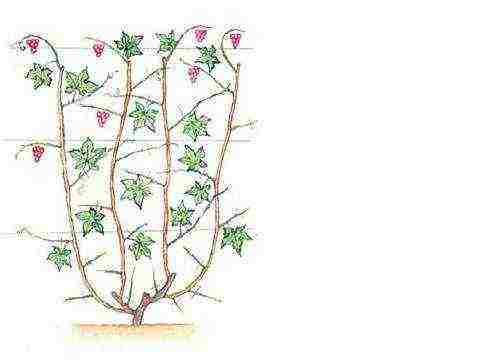
Greening of tall buildings
Sometimes it is not enough to bring out only high-standard vertical cordons, since in this case the lower part of the high wall will remain bare. It is better to alternate cordons with high and low stems or vertical cordons and fan formations through the bush so that the fan bush uses the area not occupied by the cordon bush. With this alternation, the distance between the bushes should be reduced to 1–1.2 m. In conditions of a limited area, arbor bushes will grow upward much more powerfully than trellis. The place in the sun is used rationally, and the gazebo without tears is covered with a green carpet of foliage.

If the roof of the gazebo is not solid, but openwork and needs to be decorated and harvested, for this, fruit links are formed on perennial sleeves directly from the head of the bush. You can grow one shoulder, and at the top divide it into the desired number of sleeves.Then, for a convenient cover of the bush and replacing the sleeves, it is better to grow them separately from below for each fruit link. The distance between such arms (and fruit arrows) is from 0.5 m. So, if there are two meters between the bushes, there should be four arms. In order not to increase the length of the sleeves too much, you can form several fruit links on one. It all depends on the size of the gazebo and your desire. You can, for example, close the vertical part of the gazebo with the shoots of one bush so that the next bush covers the horizontal one. If the vertical part of the gazebo faces north, only the horizontal part will have fruit links and the entire crop. You can also split the vertical cordon at a certain height and direct the takes to different sides of the gazebo.
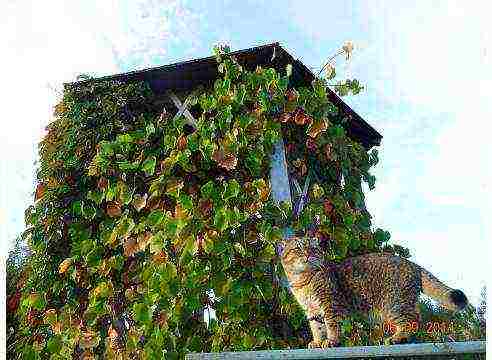
Shelter gazebo grapes for the winter
It is also necessary to form a stem, taking into account the shelter of the bush for the winter. Make around the trunk, that is, near that part of the trunk that does not bend well and does not lie on the ground, formwork from boards with a height of the trunk. Fill it with earth or bundles of reeds. In the spring, lift the uncovered part of the trunk and tie it to the trellis. Shelter and high bole are not completely mutually exclusive concepts. If you dream of growing covering varieties on a gazebo in a high-stemmed formation, I recommend updating the stem every 3-4 years so that it does not break when covered. If we talk about the interests of the grapes themselves, then an inclined arbor is more suitable for it, where an inclined stem is formed near the bush and on the slope - a fan with long fruit vines. Such a bush is comfortable to cover for the winter.
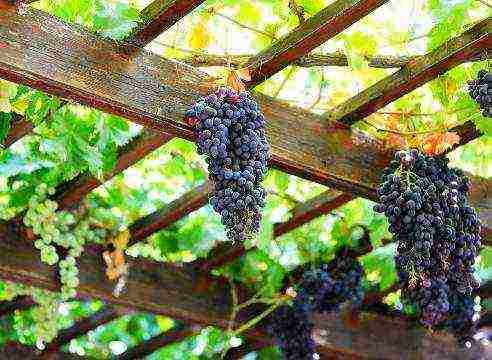
Grape varieties for gazebos
For the arbor culture, unpretentious winter-hardy vigorous grape varieties with good vine ripening, such as varieties of American origin with an isable flavor such as Alpha, Lydia, Buffalo, Valiant... If you are satisfied with beautiful, but rather late non-covering varieties with a frost resistance of more than -40 ° C, then you can grow Lydia, Isabella, Alpha, Concorde... They are shade tolerant, which means beautiful vines and leaves, edible berries, and a minimum of hassle. Another solution is vigorous Amur varieties and hybrids with frost resistance from –30 ° C and below. They are much tastier, and decorativeness is better due to the autumn coloration of leaves that is not uncommon among Amur people. This is Amur Bisexual, Taiga, Bruskam, Dvin, Khasansky Sweet, Amur A.I. Potapenko: August PE, Olenevsky Cherny, Marinovsky, Amethystovy, F.I. Shatilova: 1-95, 2-15, 2-72, many Amur hybrids of Novikov and Vaskovsky. In areas with severe winters, they are often grown with snow cover, simply by pulling them off the gazebo after pruning. And, finally, it is quite possible to grow on the northern pavilions some strong-growing table and universal varieties with beautiful berries of the most diverse selection, zoned in the middle lane: Victoria, Timur, Lando Noir, Prairie Star, Reline Pink Sidlis, Saint Croix, Frontignac and even exquisite honey Liepajas Dzintars... In addition, technical varieties can be grown Bianca, Crystal, Prim and excellent folk forms Muscat Golden Rossoshansky and Mukuzani in the classical covering agrotechnics with air-dry shelter.
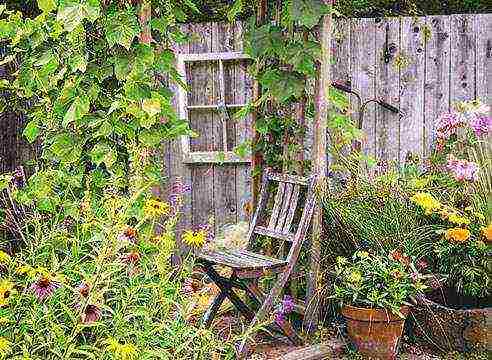
Tips for shaping grapes
- The final choice of forming depends on the task and the conditions in which you will grow the grapes. So, if the varieties are frost-resistant and you do not plan to cover them, choose a vertical cordon or a high stem with freely hanging shoots.
- If you are planning a shelter for the winter, then at your disposal are various standard and standard fan long-sleeved formations.
- If the variety is table, then the stem should be low, and the vine should be easy to fit for shelter. Therefore, table varieties, as not the most frost-resistant, are especially suitable for a standard fan-shaped formation or a horizontal cordon along Belikovaya.To obtain a good harvest, the bushes of these varieties need to be brought up in powerful formations with a large development of perennial wood. With strong pruning, there will be few bunches - only foliage.
- To obtain high-quality berries, pruning is necessary for any formation.
- Grapes are a living plastic plant, so follow the rules of formation, not literally, but creatively.
